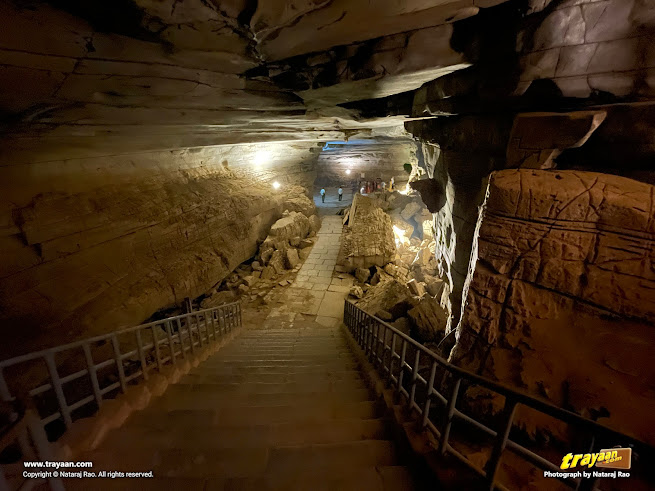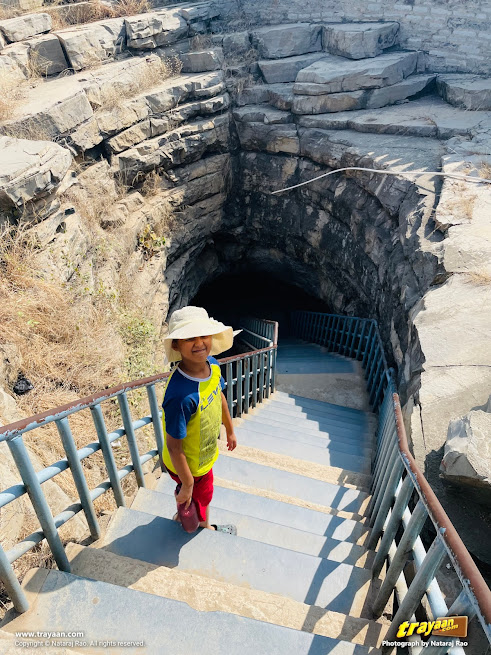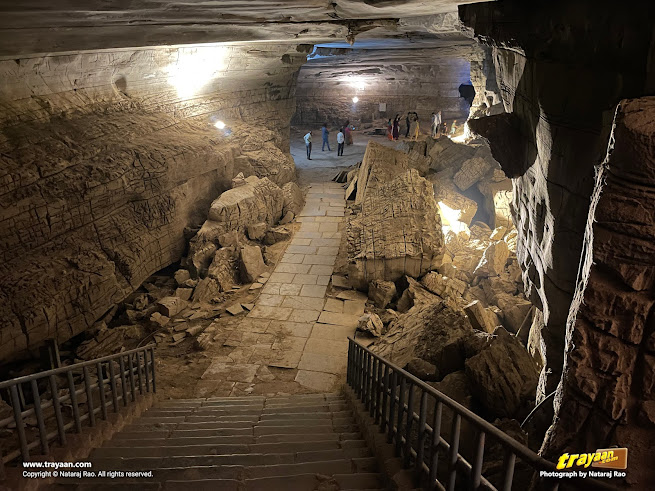A trip to this interesting natural formation, the famous underground cave system in Andhra Pradesh.
On our way to Gandikota – The Grand Canyon of India, we first visited the famous Belum caves in Andhra Pradesh. These caves are the second largest natural caves in the Indian subcontinent.
These caves are a protected monument by the ASI (Archaeological Survey of India), as they're part of India's natural heritage.
Belum Caves are nearby the Belum Village in Nandyal district (formerly part of Kurnool district), in the state of Andhra Pradesh, in India.
Jump to:
About Belum Caves
The name of the caves comes from the Sanskrit word Bilum, which means holes or tunnels under the ground. Called Belum Guhalu in the local Telugu language, these caves reach the deepest point (about 151 feet from the entrance level) at the point known as Patalganga, a perennial underground stream.
Belum Caves are the largest and longest cave system which is open to the public, in the Indian subcontinent. This cavern system has a length of 3,229 metres (about 10,594 feet), which makes them the second largest cave system known in the Indian Subcontinent. The Krem Liat Prah caves in Meghalaya is the longest natural caverns in the Indian subcontinent.
Belum caves are a system of underground caverns which were naturally formed due to an underground river which once flowed. All the patterns, speleothems, stalagmites, stalactites, and other forms in these caves are mineral deposits which were formed by the groundwater which once flowed through these underground caverns.
This cave system was known since very ancient times as remnants as old as 4,500 BCE were excavated by the Archaeological survey of India (ASI). Many remnants related to Jain and Buddhist monks were found here, indicating that they had once occupied these caves.
Not all portions of these caves are open for public. The passable passages are marked on a signboard outside.
Inside Belum Caves
Our visit to these caves
We began our trip from Bangalore at 6:00 AM in the morning. Our plan was to reach Belum Caves (290 km from Bangalore) by noon and then proceed to Gandikota. The drive on NH 44 was pleasant and if you have a car with cruise control feature, you could easily find several stretches where you can turn it on and give some rest to your foot and also burn less fuel.
Once we crossed Nandi hills, we couldn’t find any good restaurants to stop. Finally, around 9:30 AM we found a restaurant close to Anantapur and had a decent breakfast.
From the outskirts of Ananthpur, there is a bypass that connects to Tadipatri. Although a two-lane road, it was a pleasant drive. There were a couple of bad stretches near the Ultratech cement factory, but it was good overall.
We reached the caves at 11:00 AM, and to my surprise, there were no tourists! I was wondering if they were even open on a Saturday, until I noticed the open ticket counter. It costs Rs 70 for adults and Rs 50 for kids, as of now in 2023.
A large statue of Buddha that’s painted in white welcomed us just before the entry gate to the caves. The person at the entry gate checked our tickets and politely asked if we needed a guide.
As soon as we crossed the gate we saw a grand entry to a humongous cave that reminded me of some scenes from the stories of Alladin or Alibaba and forty thieves.
Walking down the stairs, we arrived at the Gebauer Hall, a great spot to get some pictures. It opens wide towards the sky and brings in those natural lighting effects for any picture that you take.
This Hall is named after H. Daniel Gebauer, the the speleologist who explored and mapped these caves in the years 1982-83.
A signboard here, although poorly lit, describes briefly about the cave’s formation, its discovery and survey.
And we walked a little further, having no idea about the sheer size and length of these caves. In some places there are narrow passageways where you have to bend or almost crawl, reminding me Jules Verne's classic A Journey To The Center Of The Earth. You'd almost think Arne Saknussem was here.
There are multiple attraction points (albeit poorly marked) within the cave. There are several sub-caves within the main caves that lead to these attraction points. I'd have preferred to see the caves in natural lighting rather than these coloured lights that illuminate at some places, which look odd.

The caves were well lit and very clean. Among the attractions, the one that I liked was The Mandapam, which appears like a hall full of pillars (a mandapa) because of the speleothems.
Other attractions are the Pathalaganga, a perennial stream flowing about 151 feet below ground level; Kotilingalu part of the cave, which is named so as several stalagmites here look like Shiva lingas; Saptaswarala Guha (meaning cave of seven musical notes), where the stalactites and stalagmites make a musical sound when tapped (However, unfortunately tapping on them may also damage them, so it is better not to touch them); Dhyan Mandir (the meditation hall); Thousand Hoods area where the natural formations look as if they are hoods of cobra, the Banyan Tree Hall, and the Maya Mandir (meaning the magical hall).

After some high-energy walks powered by our excitement, we soon felt a shortage of oxygen and the air seemed to be heavier. Due to this, we couldn’t cover all of the points within the caves. We saw some vents (of which some were working) that pumped air inside the caves.
We took a good one hour to cover about five points within the cave and came back to the Gebauer hall and took some rest. Once outside, we stopped by the Buddha statue for some pictures and then resumed our journey towards Gandikota.
Tips for travellers
Points to remember when planning this trip
- There is no food and water available once you get inside the caves. There was a Haritha hotel close the gate, but didn’t appear like it was open at the time we reached.
- There are no emergency exits or response teams for help. If you are feeling restless, it’s best to stop and return back.
- There is no cellular network coverage inside the cave, so you may not be able to make or receive mobile phone calls.
- The air gets heavy as you go deeper into the caves. People suffering from asthma and other respiratory disorders should plan accordingly.
- There were hardly any tourists when we went there. Some sections of the caves can make one nervous of any untoward incidents.
- Taller people may have to bend down for extended periods when walking through certain parts within the cave. There are also some places where you have to squeeze yourself to get through some narrow passages.
Do not touch or damage the natural formations. These have survived for centuries and need to remain so for future generations to see.
From here we proceeded towards Gandikota. See you in our next post where we explore Gandikota.
Also See : Next in this Series
• Gandikota - A serene sojourn and a splendid sunrise at the Grand Canyon of India
Location Map
Best times to visit
The best times to visit, would of course, be during the winter, unless you can bear the summer heat here.
Nearby Attractions
- Gandikota, the "Grand Canyon of India", which offers a spectacular views of Pennar river gorge or canyon along with the historical fort with heritage monuments such as Vijayanagara era temples, is around 62 Kilometres from Belum Caves.
- Mylavaram Dam which lies nearby Gandikota is a popular picnic spot which offers beautiful views and fresh breeze. It has boating services in the dam's waters as well as a park on other side.
- Tadipatri, which has the beautiful historical Sri Chintala Venkataramana Swamy Temple, is around 30 kilometres from Belum Caves.
- Owk, a town with a dam and reservoir with boating, and nearby waterfalls, is about 16 kilometres from Belum Caves.
- Two historical caves near Belum Caves in Nandyal district itself, the Valmiki Caves and the Bila Surgam, were developed in 2024 and are now accessible to the public after the renovations.
- Valmiki Caves, in Boyavandlapalle Village, is about 51 kilometres west from Belum Caves. The Valmiki Caves are naturally formed caves near Boyavandlapalli village, which is also in Nandyal District. Maharshi Valmiki is said to have visited these caves and worshipped the sacred Shivalinga in there.
- Bila Surgam caves, also in Nandyal district, is about 52 kilometres north from Belum caves.
- Belum Caves - AP Tourism Authority.
- Show Caves of India : Belum Caves - Show Caves of the World by Jochen Duckeck.
- Two historical caves open to public after renovations - Deccan Chronicle. By P.V. Prasad, on 6 February 2024 1:28 AM. Retrieved 25 December 2024.












